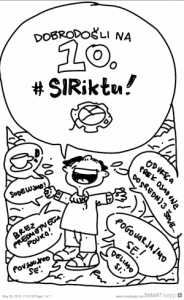Gašper Grat, SPSŠ, Šolski center Slovenske Konjice – Zreče, Slovenske Konjice
Students SPSŠ Zreče showed much creativity, because they created, with a help of their mentors, a teaching aid for controlling the low voltage electrical signals by the controller SIEMENS S7-200. Utility covers the scope of the logic operations for routing signals. In school it can be used in combination with a pneumatic and / or electrical systems, or as a self-learning unit.
For the acquisition of learning contents the device is quite universal and is used for the following areas:
- to acquire the prescribed learning content,
- the implementation of technical and informational days for the presentation to pupils from elementary schools,
- or the representing our school at various elementary schools and themed events.
In acquiring the prescribed learning content students the basics of the control logic already know. Working with the controller represents a higher degree of automation in secondary schools. At first I as a teacher introduce some basics: the purpose, the difference between the previously learned methods of control and special features. The basic control schemes in various combinations are studied and tested at first. At this stage, next to the didactic aid, some other peripheral devices are used. These devices serve mainly for visualization of the control functions (solenoid valves, pneumatic cylinders …). In the second part of this thematic section students are free for their own creativity. Only didactic aid is available for performing controlling tasks. Instead of pneumatic cylinders and valves there are lamps, installed in the push buttons on device. Lamps provides the visualization of the output of the control signals, without need for a further peripheral device. I suggest to the students a number of practical tasks such as flashing of a light under different conditions (time, number of beats, speed flashing) alternately flashing two or more lights, time-dependent two-handed safety switch for an output signal … The students must deal with those tasks alone, without any additional instructions. In any case, they have a free hand to examine and control the execution of the tasks at their own discretion. Thus, the students own initiative carried out for example, function control traffic lights, level crossings … The final method is the deductive method, when students must find the errors in the system. Students are familiar with a control task that the control system had to perform, but it is not because there is in one or more subsystems (compressed air does not apply to pneumatic components, electrical conductor is not connected or not well connected, control program is wrong …) embedded error. Students must diagnose the situation and then of course eliminate the error(s).
When implementing technical and information days at our school for presentation to elementary school pupils, the device is used in combination with pneumatic and electrical systems. The aim is in fact to show them as much as possible the scope of control systems. This presentation is based primarily on the principle described in the third example in the preceding paragraph (see the possibility of errors present in the system, their detection and correction).
When our school represent different activities by visiting various elementary schools and themed events, there are smaller workshops prepared, where participants must be firstly educated on three basic logic functions AND, OR, and NOT, and then combine consumed knowledge with didactic aid to perform some simple task of turning the lights on in different ways. Elementary school pupils usually finds out a lot of interest and creativity, because they are not occupated with other theoretical bases and basic laws in control technology.
